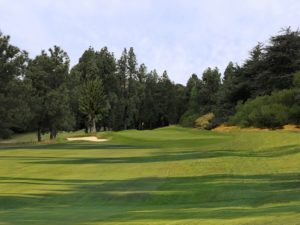Forrest Richardson, ASGCA leads renovation and restoration effort to bring Los Angeles’s beloved 9-hole course into a new era.
LOS ANGELES – Jan. 31, 2019

Conceptual rendering of Roosevelt’s 8th hole, a short par-4.
The City of Los Angeles Golf Division has undertaken a bold move to restore their nine hole gem, Roosevelt Golf Course located in its historic Griffith Park. Forrest Richardson, ASGCA is overseeing bunker and feature work, additional tees and work to return greens to their original shapes. The course is also getting a new irrigation system to accommodate the use of recycled water.
In 1927 Roosevelt consisted of a make-shift routing that used nine holes left over from the original Griffith Park Course that had been created in 1914 by Tom Bendelow. At the time Roosevelt was located on land that is currently home to the Los Angeles Zoo. In 1937, Los Angeles Parks Superintendent William Johnson and golf architect William Park Bell rebuilt the nine holes, grassing the oiled and sand greens, This “new” new version was christened Roosevelt Memorial, and it soon became a mainstay for golfers desiring to polish their short game in the span of a shorter round.
As Griffith Park grew and a new zoo was being planned, a decision was made to get rid of Roosevelt Memorial, but this quickly backfired on city officials. Golfers organized a public campaign pointing out the need for a nine hole course that took less time to play than the larger, regulation length courses. Their cries could not be ignored, resulting in a decision to relocate Roosevelt further into the park on land that would hopefully recapture the charm and interest that Bell had brought to the beloved layout. An entirely new Roosevelt took shape in 1964 under the direction of Parks department staff. David Kent and landscape architect John Ward are credited with the design that now sits below the famous Griffith Park Observatory.
“Our charge has been to pay homage to the history of Roosevelt, which includes both the work of Bell and what was built on the 1960s site,” notes Forrest Richardson. “Today the setting is elevated well up in the park, so we have dramatic hills and valleys that form the heart and strategy of the holes.” Richardson’s work is aimed at making the course friendly to beginners and occasional golfers, while preserving the solid test that Roosevelt has come to be known for. The par-33 layout remains, but forward tee yardage will be reduced by more than 500-yards to accomplish the goals set forth by the City.
Bunkers total just five, ranging from classic greenside bunkers to a cross bunker on the par-4 fourth hole. “The defense of the course is all about the natural terrain and the drama you get from playing up, down and around,” notes Richardson. “The last thing Roosevelt needs is an abundance of bunkers to make it interesting.”
City of Los Angeles staff is heading up tree removal with guidance from Richardson. Led by Golf Division Director Laura Bauernfeind, who previously served as the City’s Principal Forester, the removal of trees has focused on opening views, allowing more light and air circulation, as well as getting rid of species that are invasive to the Griffith Park’s natural landscape. Richardson applauds the work, noting “It’s tremendous to see what happens when you open views, now we can not only see the Observatory, but there are several breathtaking views looking out toward downtown Los Angeles.”
Heritage Links is the golf course builder assigned to the course restoration work, with the Better Billy Bunker system being used for bunker construction. The work is expected to be completed for opening in Spring 2019.
